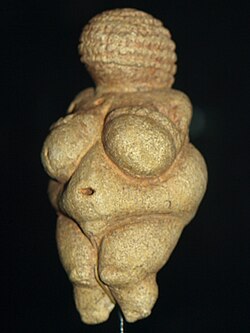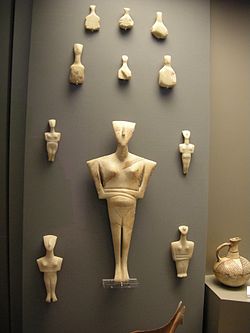Art and our world/ART103/Identity
The art historical record is filled with images of ourselves. Generally, the further back we go, the more anonymous these visages are. For example, the earliest works of art – crudely chiseled stone sculptures – record the human figure in exaggerated forms. The Venus of Berekhat Ram is dated to around 230,000 years ago. It, and other small stone figures from the same period, indicate that artistic expression was part of a pre-homo sapiens culture. There is now evidence of an art instinct: a natural inclination for humans to be creative and perceive our surroundings with an aesthetic sense.
Ancient Jōmon cultures of Japan produced extremely stylized earthenware figures, often female and, similar to the Venus figures of Western Europe, with enlarged breasts and hips but disproportionately short arms and legs. Thought to be ritual figures, the earliest examples are faceless and without adornment.[1] Later ones show generic features with curious insect eyes and more elaborate decoration.[2]
We start to see human figures with individual characteristics during the Old Kingdom dynasties of Egypt about 2500 BCE. Reserved for royalty and other high-ranking figures, these portrait sculptures, many times containing a man and women together, include an emotional connection as they stand or stride forward with their arms around each other. See example below left. In another example, below right, an Egyptian scribe sits cross-legged with his palette and papyrus scroll and a hairstyle comparatively similar to that of the Venus of Willendorf. Here, we get a much stronger sense of identity and form, with detailed description of the scribe's facial features, subtle but important rendering of musculature and even individual fingers and toes, all sculpted in correct proportion and scale.
Greek vase painting[3] uses figurative and decorative motifs to illustrate mythic narratives or simply depict scenes from everyday life. Many of the vases show athletic games, social gatherings or musical entertainment. The image on the amphora below left depicts a foot race run with weapons, known as a Hoplitodromos.
The Romans used painted portraits to commemorate the dead. Commonly known as Fayum mummy portraits, they were created with encaustic or tempera paints on wooden panels and placed over the face of the mummified body. The portraits all show the same stylistic characteristics including large eyes, individual details and the use of only one or two colors. The portrait below right shows a young man with curly hair and light beard. There is also a melancholy psychological element as the figure stares back at us.
Portraiture and the figure continue to be important motifs in modern and contemporary art. Pop artist, Andy Warhol, used photographs of politicians and Hollywood celebrities to create series of images that supplant traditional painted portraits and reinforce our idea of brand identity. His diptych of Marilyn Monroe from 1963 signifies her place on popular culture's altar as an icon of beauty and sexuality while alluding to her tragic suicide in 1962. The print's bright colours and rapid-fire images on the left hold our attention, while on the right we see her fading away into obscurity in black and white. With this staccato image format Warhol presents us with conflicting alternatives: the ubiquitous nature of celebrity and the fleeting nature of life.
Bruce Nauman's neon sculpture Human/Need/Desire uses words that uncover "fundamental elements of human experience.*" The pulsating neon sculpture has a trance-like effect as the viewer watches the words change in front of them. The work provides a collective meaning because we can all identify with its message.
The painter Alice Neel's portraits are exceptional, as they capture a sitter's likeness and character but with an expressionist edge. She preferred informal poses, used harsh colors and an unerring sense of design in portraits of family, friends, fellow artists, and political personalities.
Finally, in an artistic gesture that redefines what portraiture and self identity can be, Spanish-born artist Inigo Manglano-Ovalle does away with the figure altogether. His three-panel chromogenic print Glen, Dario and Tyrone presents us with the DNA signature of each individual. This work blurs the line between art, science, and technology. Now, a portrait is manifest, as blobs of colour and its integrity is established by the fact that each series of blobs is genuinely different than any other. This creative idea has even migrated to the marketplace: You can order your own (or someone else's) DNA portrait for the home or office.
The theme of "mother and child" is common to most world cultures, but the form and content within the theme changes. View the two examples from this theme:
- Mother and Child sculpture from the Bamana culture of Africa
- Mary Cassatt’s Maternal Caress from western European culture
In your private learning journal, compare and contrast them in terms of their forms and the content they reflect.
Read the descriptions about each of the works to help you determine any difference, but use your own words to describe the works. Be specific in your answers. Your descriptions should include:
- Subject matter: What does the work represent?
- Formal qualities of each work and their visual effects on the viewer
- Areas of focus: What's included and what isn't?
- Issues of content: What meaning do you get out of each work? Is it different for both or the same? Why? Why not?
- In what context is each work seen? Does that make a difference in the content?
Find a third image from this theme on your own and share the link to it with others in the course feed. Make sure your choice represents a different culture than the first two (African and western European). Be sure to use proper citation for any source material you refer to.
Note: Your comment will be displayed in the course feed.
Notes
- ↑ An example of an early period Jōmon figurine at The Metropolitan Museum of Art
- ↑ An example of a late period Jōmon figurine at The Metropolitan Museum of Art
- ↑ For more on Greek vase painting, visit Athenian Vase Painting: Black- and Red-Figure Techniques at The Metropolitan Museum.








